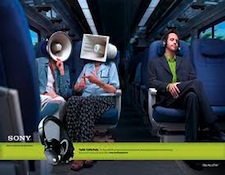It’s the time of year for saving money!

Steve Guttenberg wrote an interesting article comparing noise-cancelling with noise-blocking headphones in the subways and on the streets of NYC. In his article Guttenberg found that noise-cancelling headphones were marginally more effective at reducing outside noise.
While I don’t dispute his observations, I do feel that noise-cancelling headphones do have several issues that make them a less desirable option when all other things are equal (like price.)
Noise-cancelling is usually an active circuit that requires power in the form of a battery – this makes noise-cancelling headphones more prone to failure due to battery expiration, exhaustion, or circuit failure.
Noise-cancelling is based on generating an out-of-phase signal that cancels out the in-phase background noise. Depending on the ambient noise level, this means a substantial amount of out-of-phase energy that must be generated by the power amp driving the headphones. In extreme cases dynamic music at high volumes can push a headphone amp past its normal operating zone into clipping.
Due to the need for a battery and additional circuitry most noise-cancelling headphones have been larger over-ear rather than in-ear designs. While this allows for bigger transducers, it also adds weight, making for a bulkier device. If you prefer to travel light that extra bulk and weight could be a problem.
Noise-cancelling headphones often sound differently with their noise-cancelling circuits on. I noticed this far more on earlier generation earphones than on the latest, such as the M4U phones from PSB, but in worst-case situations the noise-cancelling circuit can act as comb filter, emphasizing some frequencies while reducing others. The pitch of the background noise often shifts when the noise-cancelling circuit is turned on or off. Again, I’ve noticed the effect less with the latest generation of noise-cancelling phones, such as the PSB.
TAD designer Andrew Jones noted in a comment to Guttenberg’s article that with some noise-cancelling phones the circuitry is never really off, so that when the battery goes, so does your sound. Another problem with an always-on circuit is that when it fails your phones will be always off…
Andrew brings up another point – how comfortable is your headphone or earphone when you try to catch a nap on the plane? Some in-ear phones, such as the Etymotic, do sit well into your ear canal, so additional pressure can be not only uncomfortable, but also physically dangerous. In extreme cases you can actually scratch your eardrum. Especially during the descent, when the positive air pressure can actually push in-ear phones even farther into your ear, this could be a problem. The Shure SE215 I reviewed in AVGuide were especially good for airline sleeping due to their small size and outer-ear canal seal. The Ultimate Ears In-Ear Reference Monitors are also quite comfortable for sleeping even though they go well into the ear canal because they have such a shallow footprint outside the ear.
This whole discussion loops us back to the most critical aspect of headphones and earphones – the fit. I’ve looked at this issue before, and most likely it will come up again, since it ‘s the primary reason that users like or dislike a set of cans.
As more and more premium headphones incorporate noise-cancelling as a standard feature, we can expect additional noise cancelling methodologies to emerge. I suspect that eventually we will have a noise-cancelling technology that is both sonically transparent, physically robust, and comfortable, regardless of your ear shape or situation. I can’t wait.





